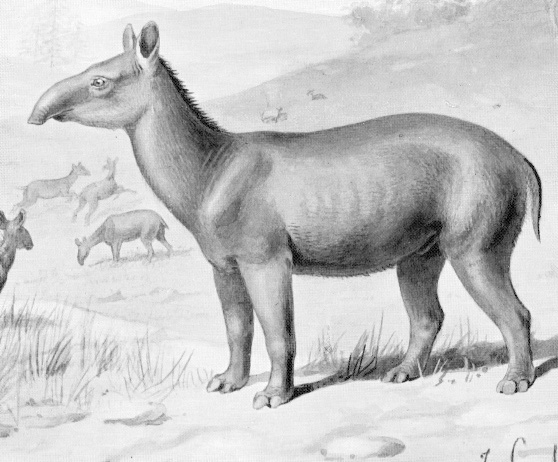|
Palaeothere
Palaeotheriidae is an extinct family of herbivorous perissodactyl mammals related to equids. They ranged across Europe and Asia from the Eocene through to the early Oligocene 55–33 Ma, existing for approximately . Living in dense forests, they ate soft leaves, shoots, berries, and leaf matter picked up from the forest floor. Morphology Palaeothere sizes ranged from at the shoulder, and weighed an estimated .S. Legendre. 1988. Les communautes de mammiferes du Paleogene (Eocene superieur et Oligocene) d'Europe occidentale: structure, milieux et evolution. Ph.D. thesis, Universite des Sciences et Techniques du Languedoc, Montpellier, France. 2 volumes. 1-265 Extinction Evidence suggests that the palaeotheriidae went extinct in Eurasia during the Early Oligocene, approximately 33 Ma, as part of a faunal turnover event known as the Grande Coupure. The Eocene-Oligocene transition marked a significant global cooling event caused by the onset of Antarctic glaciatio ... [...More Info...] [...Related Items...] OR: [Wikipedia] [Google] [Baidu] |
Palaeotherium
''Palaeotherium'' (Ancient Greek for 'old beast') is an extinct genus of perissodactyl ungulate known from the Mid Eocene to earliest Oligocene of Europe. First described by French naturalist Georges Cuvier in 1804, ''Palaeotherium'' was among the first Paleogene mammals to be described. Taxonomy ''Palaeotherium'' belongs to the family Palaeotheriidae, a group proposed to consist of two subfamilies, the Palaeotheriinae representing ''Palaeotherium'' and the Plagiolophinae containing the closely related '' Plagiolophus''. Although at times proposed to be ancestral to modern horses the palaeotheres are now considered a sister taxon to the Equidae, and not part of the same lineage. The species and subspecies referable to ''Palaeotherium'' are a subject of debate, due in part to the diversity of species within the genus. Species and subspecies are mainly assigned based on dental and cranial characteristics. Description ''Palaeotherium'' was a diverse genus of herbivorous perissod ... [...More Info...] [...Related Items...] OR: [Wikipedia] [Google] [Baidu] |
Hyracotherium
''Hyracotherium'' ( ; "hyrax-like beast") is an extinct genus of very small (about 60 cm in length) perissodactyl ungulates that was found in the London Clay formation. This small, fox-sized animal was once considered to be the earliest known member of Equidae before the type species, ''H. leporinum'', was reclassified as a palaeothere, a perissodactyl family basal to both horses and brontotheres. The remaining species are now thought to belong to different genera, such as ''Eohippus'', which had previously been synonymised with ''Hyracotherium''. Description ''Hyracotherium'' averaged 78 cm (2.5 feet) in length and weighed about 9 kg (20 pounds). It had a short face with eye sockets in the middle and a short diastema (the space between the front teeth and the cheek teeth). The skull was long, having 44 low-crowned teeth. Although it had low-crowned teeth, the beginnings of the characteristic horse-like ridges on the molars can be seen. ''Hyracotherium'' is believed ... [...More Info...] [...Related Items...] OR: [Wikipedia] [Google] [Baidu] |
Equid
Equidae (sometimes known as the horse family) is the taxonomic family of horses and related animals, including the extant horses, asses, and zebras, and many other species known only from fossils. All extant species are in the genus '' Equus'', which originated in North America. Equidae belongs to the order Perissodactyla, which includes the extant tapirs and rhinoceros, and several extinct families. The term equid refers to any member of this family, including any equine. Evolution The oldest known fossils assigned to Equidae were found in North America, and date from the early Eocene epoch, 54 million years ago. They were once assigned to the genus ''Hyracotherium'', but the type species of that genus is now regarded as a palaeothere. The other species have been split off into different genera. These early equids were fox-sized animals with three toes on the hind feet, and four on the front feet. They were herbivorous browsers on relatively soft plants, and already adapted ... [...More Info...] [...Related Items...] OR: [Wikipedia] [Google] [Baidu] |
Eocene
The Eocene ( ) Epoch is a geological epoch (geology), epoch that lasted from about 56 to 33.9 million years ago (mya). It is the second epoch of the Paleogene Period (geology), Period in the modern Cenozoic Era (geology), Era. The name ''Eocene'' comes from the Ancient Greek (''ēṓs'', "dawn") and (''kainós'', "new") and refers to the "dawn" of modern ('new') fauna that appeared during the epoch. The Eocene spans the time from the end of the Paleocene Epoch to the beginning of the Oligocene Epoch. The start of the Eocene is marked by a brief period in which the concentration of the carbon isotope Carbon-13, 13C in the atmosphere was exceptionally low in comparison with the more common isotope Carbon-12, 12C. The end is set at a major extinction event called the ''Grande Coupure'' (the "Great Break" in continuity) or the Eocene–Oligocene extinction event, which may be related to the impact of one or more large bolides in Popigai impact structure, Siberia and in what is now ... [...More Info...] [...Related Items...] OR: [Wikipedia] [Google] [Baidu] |



